Sold antiquities
Archive of sold antiquities
All artefacts sold in our gallery are fully documented in our online archive and database. Being a specialist ancient art dealer, preserving also the more recent history of each and every piece sold in our shop is at our heart. That is particularly useful for artefacts that changed owners in the meantime. Information that may have been lost in the process can be easily restored from our archives. Please do not hesitate to contact us if you need further information about ancient items that have been sold in our gallery. We can help you with reconstructing the history of ownership for those items. All information about our customers will be kept confidential, of course.-
 Large Villanova culture krater
Large Villanova culture kraterVery large, impressively preserved object. From an old Dutch private collection.
Price: on request Large published Cypriot amphora
Large published Cypriot amphoraVery large, impressively preserved object. From an old German private collection, acquired at London art gallery or auction around 1970. Coming with an ArtLoss certificate.
Price: on request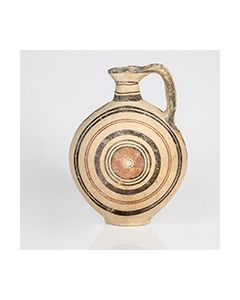 Large published Cypriot oinochoe
Large published Cypriot oinochoeDating to the early cypro-archaic period, so-called bichrome ware IV. From an old German private collection, acquired at Sotheby's in 1970. Coming with an ArtLoss certificate.
Price: on request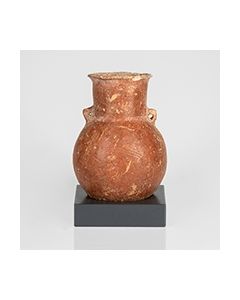 Published cypriot amphora, ex Sotheby's
Published cypriot amphora, ex Sotheby'sFully preserved, early vase from the Bronze Age. 1977 on exhibition in the Bielefeld Museum of Fine Arts. From an old German private collection, acquired 1970 at Sotheby's. Coming with an ArtLoss certificate.
Price: on request Roman oil lamp from the collection of Shlomo Moussaieff
Roman oil lamp from the collection of Shlomo MoussaieffVery nicely preserved piece, from a famous Israeli collection. IAA export permit available.
Price: on request Large published cypriot jug, ex Christie's
Large published cypriot jug, ex Christie'sExcellently preserved, rare for such a large object. 1977 on exhibition in the Bielefeld Museum of Fine Arts. From an old German private collection, acquired at Christie's in the late 1960s or early 1970s. Coming with an ArtLoss certificate.
Price: on request Very large cypriot bowl
Very large cypriot bowlDating to the early cypro-archaic period, so-called black-on-red ware II. From an old German private collection. Coming with an ArtLoss certificate.
Price: on request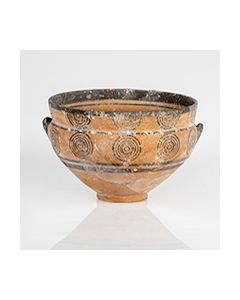 Large cypriot bowl, ex Sotheby's
Large cypriot bowl, ex Sotheby'sDating to the early cypro-archaic period, so-called black-on-red ware II. From an old German private collection, acquired 1970 at Sotheby's. Coming with an ArtLoss certificate.
Price: on request Published cypriot kylix, ex Christie's
Published cypriot kylix, ex Christie'sExcellently preserved. 1977 on exhibition in the Bielefeld Museum of Fine Arts. From an old German private collection, acquired 1972 at Christie's. Coming with an ArtLoss certificate.
Price: on request Large published cypriot krater, ex Sotheby's
Large published cypriot krater, ex Sotheby'sFully preserved piece, very rare for an object of this size. 1977 on exhibition in the Bielefeld Museum of Fine Arts. From an old German private collection, acquired 1971 at Sotheby's. Coming with an ArtLoss certificate.
Price: on request Published cypriot milk bowl
Published cypriot milk bowl1977 on exhibition in the Bielefeld Museum of Fine Arts. Nicely preserved piece, from an old German private collection, acquired prior to 1972. Coming with an ArtLoss certificate.
Price: on request Published etruscan hydria or amphora
Published etruscan hydria or amphora1969 on exhibition in the Stadtsparkasse Gelsenkirchen, published in the exhibition catalogue. Perfectly preserved, from an old German private collection, acquired in the 1970s at Galerie Hermanns, Munich. Coming with an ArtLoss certificate
Price: on request Etruscan red figure Kylix
Etruscan red figure KylixThe tondo shows an elaborate depiction of two men. From an old German private collection, acquired 1979 at René Gott gallery, Geneva. Coming with an ArtLoss certificate
Price: on request Large early Etruscan decorated jar
Large early Etruscan decorated jarNicely preserved, from an old German collection, acquired in the late1950s. Found in Latium region (Italy) near Sezze.
Price: on request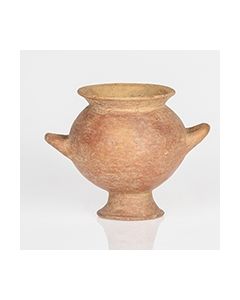 Perfectly preserved Etruscan storage jar
Perfectly preserved Etruscan storage jarRare object type, perfectly preserved. From an old German collection, acquired in the late1950s. Found in Latium region (Italy) near Sezze.
Price: on request Large Etruscan oinochoe: Found in Cerveteri
Large Etruscan oinochoe: Found in CerveteriVery impressive, large vase from an old German collection, acquired in the late1950s. Found in a tomb near Cerveteri. Coming with an Art Loss certificate.
Price: on request Roman transport amphora found at Cabrera island
Roman transport amphora found at Cabrera islandPerfectly preserved, large amphora from the Mediterranean sea. From an old German collection.
Price: on request Roman transport amphora found at Cabrera island
Roman transport amphora found at Cabrera islandNicely preserved amphora from the Mediterranean sea. From an old German collection.
Price: on request Roman transport amphora found at Cabrera island
Roman transport amphora found at Cabrera islandPerfectly preserved, large amphora from the Mediterranean sea. From an old German collection.
Price: on request Brooch with copy of Euainetos decadrachmon
Brooch with copy of Euainetos decadrachmonVery detailed galvano-copy of a specimen from a museum or an important collection, rew-orked to an elegant brooch. Perfectly preserved, from an old German collection.
Price: on request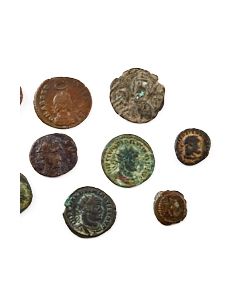 11 Roman coins from an old German collection
11 Roman coins from an old German collectionThe small collection features different emperors from the late Roman Empire and the early Byzantine era. From the collection of Prof. Schmid, acquired in the late 1970s - early 1980s.
Price: on request Alexander the Great drachm
Alexander the Great drachmEarly posthumous specimen from Kolophon, Ionia. Acquired 1984 from the Münzen- und Medaillenhandlung Stuttgart, Germany.
Price: on request Perfectly preserved corinthian stater with triton
Perfectly preserved corinthian stater with tritonBeautiful dark patina, ex Athena Coins Munich, acquired 1980
Price: on request Bracelet with snake heads
Bracelet with snake headsMassive bronze bracelet dating to Late Antiquity. Snake shaped terminals.
Price: on request Bracelet with animal heads
Bracelet with animal headsMassive bronze bracelet dating to Late Antiquity. Animal head shaped terminals.
Price: on request Rare Anactorion stater
Rare Anactorion staterObv: Flying Pegasos, Rev: Helmeted head of Athena, with bucranion and monograms. Above KLE.
Price: on request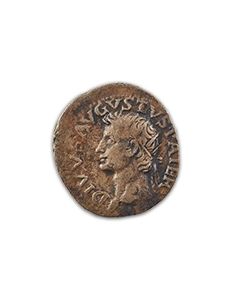 Augustus As: Winged thunderbolt
Augustus As: Winged thunderboltStruck under Tiberius, circa 34-37 AD. From an old German collection, acquired in Athena Gallery in Munich in 1980.
Price: on request Egyptian ushabti for Somtus-tefnacht
Egyptian ushabti for Somtus-tefnachtThe mummiform funerary figurine dates to the Late Period of ancient Egypt, 26th to 31st dynasty. It is remarkable that it probably originates from the burial of two brothers, Somtus-tefnacht and Somtus-tefnacht.
Price: on request Ushabti for Ra-mes
Ushabti for Ra-mesThe mummiform funerary figurine dates to the Late Period of ancient Egypt, 26th to 31st dynasty. It is remarkable that it probably originates from the burial of two brothers, Ra-mes and Somtus-tefnacht.
Price: on request Egyptian ushabti for Ra-mes
Egyptian ushabti for Ra-mesThe mummiform funerary figurine dates to the Late Period of ancient Egypt, 26th to 31st dynasty. It is remarkable that it probably originates from the burial of two brothers, Ra-mes and Somtus-tefnacht.
Price: on request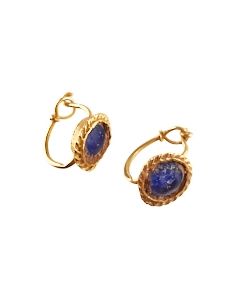 Pair of Roman gold earrings
Pair of Roman gold earringsNice golden earrings with blue glass inserts from late Roman Imperial times. It is a belonging pair of earrings which is in itself a rarity.
Price: on request Gold earrings with Nike pendants
Gold earrings with Nike pendantsGreek hellenistic earring pair made of gold and emerald. Beautiful jewellery with granulated rosettes, emerald beads and plastic Nike statuettes. Including material analysis report.
Price: on request Beaker of the Nazca culture
Beaker of the Nazca cultureElegant vessel made by the precolumbian Nazca culture. The outside is decorated by a polychrome szene of geometric patterns and abstractions of animals and faces.
Price: on request Mochica stirrup vessel
Mochica stirrup vesselThe body is creatively shaped as a bird man. A wonderful testimony to the last bloom of the Mochica culture before its collapse.
Price: on request Bronze Age Axehead Hoard
Bronze Age Axehead HoardOriginal group dating to the Middle Bronze Age of Northern Europe. It was buried around 3400 years ago south of Chiddingford in Great Britain.
Price: on request Roman transport amphora found at Cabrera island
Roman transport amphora found at Cabrera islandPerfectly preserved, large amphora from the Mediterranean sea. Attractive marine patina.
Price: on request

